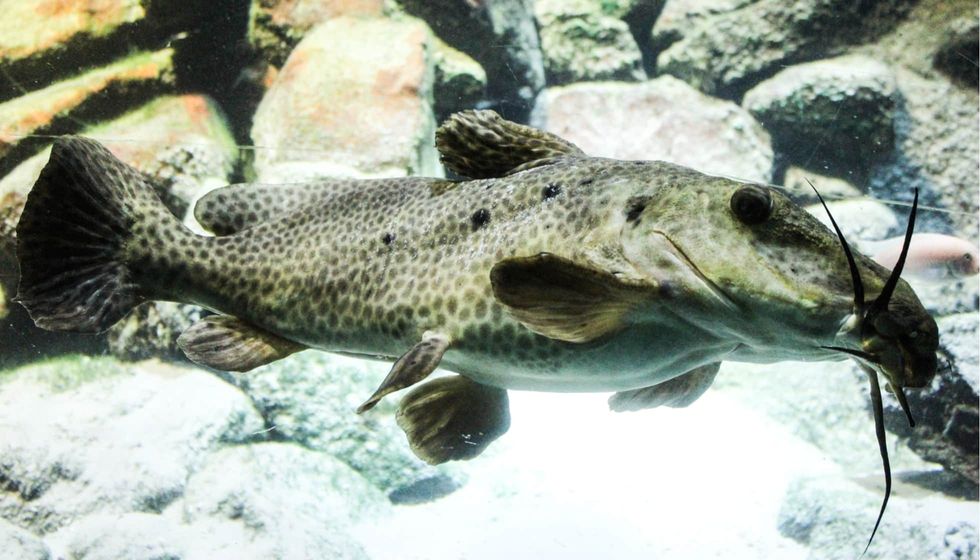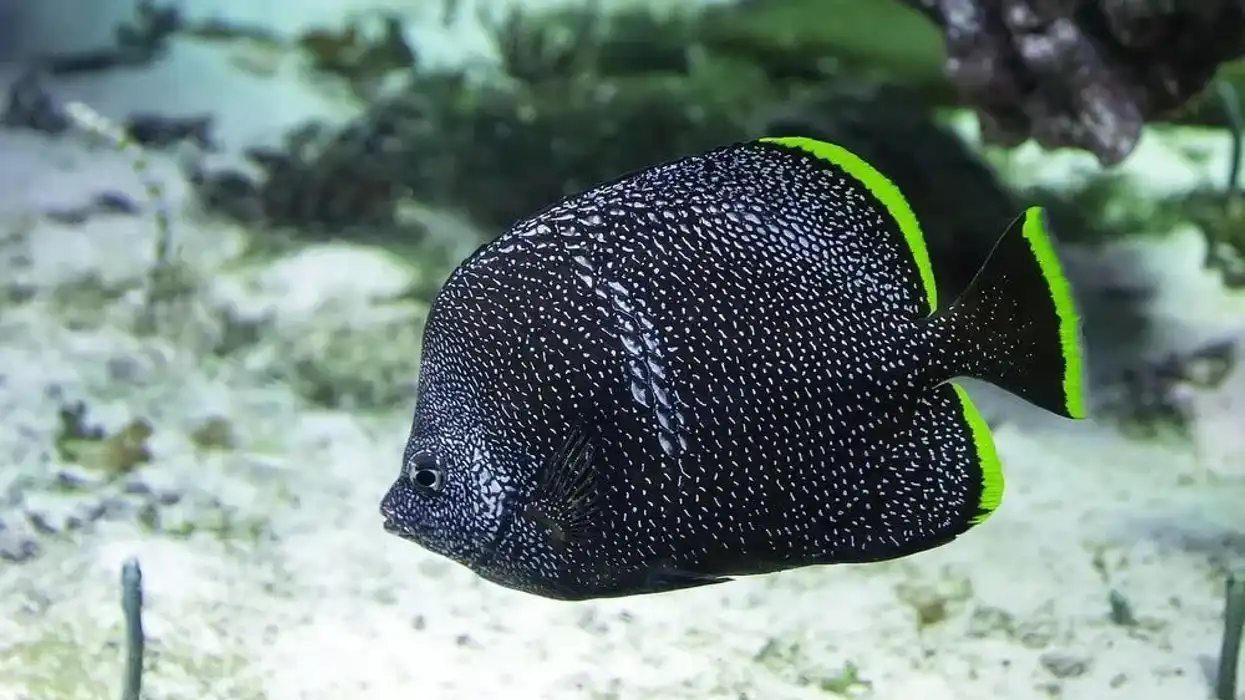The giraffe catfish (Auchenoglanis occidentalis) is a large fish species that can grow rapidly. It has the scientific name Auchenoglanis occidentalis, and it is an African catfish that feeds on plants that grow on the bottom of lakes and streams.
The giraffe catfish (Auchenoglanis occidentalis) is a tough and adaptable creature with a unique spotted appearance. These large shallow-swimming freshwater fish can be found in various shallow lakes and rivers with high mud substrate, and this species has a wide range of habitats.
They are undemanding in an aquarium too. Despite their rugged appearance, they make ideal tankmates for comparatively peaceful big fish.
The Auchenoglanis occidentalis is a scavenger that eats insects and can readily tolerate any sinking foods. If you enjoy our article on the giraffe catfish (Auchenoglanis occidentalis), do read other articles on the redtail catfish and spotted catfish too.
Giraffe Catfish Interesting Facts
What type of animal is a giraffe catfish?
The giraffe catfish (Auchenoglanis occidentalis) is an African catfish belonging to the family Claroteidae.
What class of animal does a giraffe catfish belong to?
The giraffe catfish (Auchenoglanis occidentalis) belongs to the class Actinopterygii.
How many giraffe catfish are there in the world?
No survey has been conducted on the population of this species. Therefore, the total population of these fish is unknown.
Where does a giraffe catfish live?
This famous fish of the Congo River can adapt to a wide variety of environments, but their long-term growth is better in slightly sluggish, acidic water. Thriving at a temperature up to 64 F (18 C) and at a pH of 6.5-7.8, this fish can be found in lakes and rivers all over Africa.
It prefers shallow waters and water bodies with rocky bottoms.
What is a giraffe catfish's habitat?
The giraffe catfish (Auchenoglanis occidentalis) finds its habitat in lakes and rivers such as the River Nile, the Congo River, and Lake Chad. Its range of distribution encompasses freshwater bodies from east to west Africa.
Who do giraffe catfish live with?
In the wild, the giraffe catfish (Auchenoglanis occidentalis) is a solitary fish, according to the small amounts of evidence that we have. It is a very calm fish that does not harm or get aggressive with most of its tankmates.
Regardless, owners of this fish in captivity must provide it with a very large tank size and choose its tankmates with caution. It is important to make sure that any other fish or creatures in the tank are not too small, or this beast might treat them as prey.
How long does a giraffe catfish live?
These huge fishes can grow up to 36 in (91.4 cm) and, under ideal conditions, can live for more than 20 years.
How do they reproduce?
There is not much evidence and data about the breeding of this species but we do know that it is a nest builder. The male usually guards the spread-out eggs and there have also been some recorded instances of interspecific brood care.
What is their conservation status?
This fish is classified as a species of Least Concern because it has a wide range of habitats. However, in North Africa specifically, it is Endangered, and in areas of eastern Africa, it is overfished.
Giraffe Catfish Fun Facts
What do giraffe catfish look like?
Auchenoglanis occidentalis fish have the common name of giraffe catfish because of the mottled brown spots and patches all over their bodies, resembling the markings of a giraffe. These patterns, with age, grow into a base color that is creamy yellow with a dark brown top layer.
How cute are they?
This big-sized African-origin fish is quite cute and is loved by aquarium enthusiasts.
How do they communicate?
There is not much information regarding the communication methods of this species. However, it is known that they communicate with the help of vibrations.
How big is a giraffe catfish?
In the wild, these fish can grow up to 36 in (91.4 cm) in length. They usually grow up to be somewhere between 20-28 in (51-71 cm) long in an aquarium. This fish is 13 times smaller than the world's largest fish (the whale shark) which is 18-33 ft (5.5-10 m) in size.
How fast can a giraffe catfish swim?
Not much is known about the swimming mechanisms and the speed of this species.
How much does a giraffe catfish weigh?
This big-sized African-origin fish needs a large aquarium as it weighs quite a lot, thus requiring the aquarium to be strong. However, this species' exact weight range is currently unknown.
What are the male and female names of the species?
There is no specific name for male and female Auchenoglanis occidentalis fish.
What would you call a baby giraffe catfish?
Young fish of this species are called fry.
What do they eat?
This species of catfish is a versatile eater who can eat a mixture of meat and vegetable foods. This mixture helps them to stay healthy and build up a strong immunity.
Earthworms, prawns, good quality big sinking pellets and frozen foods like bloodworm, white mosquito larvae, and Mysis shrimp are all good foods to consider for your pet Auchenoglanis occidentalis.
Its food selection in the wild consists of several small fish, shrimps, and other small freshwater species. Some pieces of evidence suggest that these fish also consider some freshwater plants as their food.
Are they dangerous?
These are peaceful fish, but due to their large size, they might cause problems or damage to their habitat. They might consider small fish in the tank as food and thus become a danger to them.
If their tanks are not strong enough or are too light in weight, they may break the tank, causing danger. Overall, this species is peaceful and calm and usually does not pose a threat.
Would they make a good pet?
For enthusiasts, this fish can be a great pet but it is not the easiest species to maintain and requires extensive care. The tank water should maintain between pH 6.5-7.8, and the tank size should be very large, around 350-400 gal (1325-1514 L).
This large aquarium must have a good filtration process too.
Due to its large size, the filtration system of the tank should be powerful, with two or more filters. Feeding the fish with an adequate diet and food is also not easy, and feeding can also be expensive.
The temperature range required for this fish is between 69.8-77 F (21-25 C ).
Regardless, it is a peaceful fish and will not cause trouble to any other fish of a similar size. It is important to remember that, because its feeding patterns and diet include fish of a smaller size, it might view these as prey if kept in a tank with them.
Did you know...
Some sources suggest a geographical color variation of this catfish species. In total there are eight different species of this type of fish.
This fish requires a water temperature somewhere around 64 F (18 C) and to be between pH 6.5-7.8 for its optimal growth and immune function.
Name the predators of the giraffe catfish?
This large catfish species is on top of the food chain in its habitat in the rivers around east and west Africa. Due to this fact, there are no predators of these fish.
How to identify this catfish?
This species can be identified by its size and its defining giraffe-like color patterns which gave it the famous common name it is recognized by.
Here at Kidadl, we have carefully created lots of interesting family-friendly animal facts for everyone to discover! Learn more about some other fish from our blue catfish facts and cory catfish facts pages.
You can even occupy yourself at home by coloring in one of our free printable giraffe catfish coloring pages.










